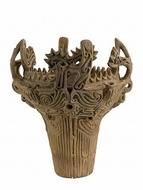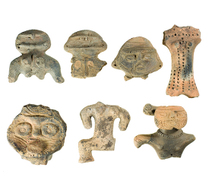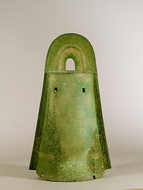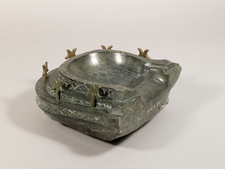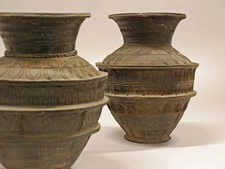- Haut de page
- exposition permanente
- zone Archéologie
L’archéologie est une discipline qui essaie de reconstituer l’histoire de
l’humanité, des temps des sociétés sans écriture à nos jours, en analysant
les « objets » enfouis sous la terre, vestiges, sites ou artéfacts matériels. Ici, nous
nous appuyons sur les documents archéologiques accumulés au musée depuis les
temps du Laboratoire d’archéologie afin de retracer l’histoire de l’archipel japonais
compris en lien avec l’histoire globale du monde. Les recherches scientifiques
menées par le Laboratoire d’archéologie, département des études littéraires de la
faculté de lettres, répondent aux travaux d’archéologie du shintô propres à
l’université Kokugaku.in pour permettre de remonter à la recherche du coeur des
êtres qui ont peuplé cet archipel.
On occasion in this museum, some materials which are in the publication are not exhibited as they are changed on demand.
Catalogue
-
Clay figurine (dogū)
Late Jōmon-final Jōmon period, ca. 2500-300 B.C.E.
Tatsugi shell mound, Tatsugi, Tone Town, Ibaraki Pref., Shinpukuji shell mound, Iwatsuki Ward, Saitama City, Saitama Pref., etc.Human figurines from the Jōmon period are thought to represent a belief in supernatural beings. While produced from the earlie...more
-
Bronze bell (dōtaku) with crossed-bands pattern
Thought to have been excavated from the Ōiwayama site, Koshinohara,Yasu City, Shiga Pref.
Middle Yayoi period, ca.1st century B.C.E.These artifacts are called the "Tossenchū type 1"; among bronze bells characterized by cross-band patterns of six sections dr...more
-
Bronze mirror with triangular rim, design of three deities and three animals
Early Kofun period, ca. 4th century C.E.
From the Ōtsuki Bankei collectionThis mirror is believed to belong to one of the last groups of imported mirrors, prior to the socalled imitative triangular rimm...more
-
Pottery with human face and raised hands
Early Kofun period, ca. 4th century C.E.
Katayama site, Wakaho-Hoshina, Nagano City, Nagano Pref.Located on the southern bank of the Hoshina River (tributary of the Chikuma River), the Katayama site is an unusual archaeologi...more
-
Stone pillow (Important Cultural Property)
Middle Kofun period, ca. 5th century C.E. Gift of the Archaeological Society of Kokugakuin University
Anesaki Futagozuka Tumulus, Anesaki, Ichihara City, Chiba Pref.The Anesaki Futagozuka Tumulus located in the Yōrō River basin is a keyhole-shaped tomb mound that can be dated to the late-midd...more
-
Cinerary urn
Heian period, ca. 9th century C.E.
Kaneda Government Office site (found within the Kokonoe-Higashioka abandoned temple site), Higashioka, Tsukuba City, Ibaraki Pref.The ruins of the ancient Kaneda Government Office site are located in the west-bank river basin of the Sakura River. The site rep...more













